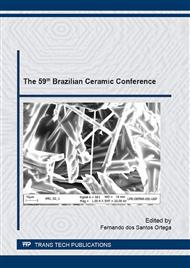p.71
p.77
p.83
p.91
p.97
p.103
p.111
p.117
p.123
Effect of TiB2 on Pressureless Sintering and Hot Pressing of ZrB2
Abstract:
Zirconium diboride (ZrB2) is a material of particular interest because of the excellent and unique property combination of high melting point and high electrical and thermal conductivity. In this work, the effect of TiB2 addition on pressureless sintering and hot pressing sintering of ZrB2 was investigated. Four compositions were prepared with 0, 5, 10 and 20 wt% of TiB2. First, ZrB2 and TiB2 powders were milled by planetary mill with SiC spheres at for 4 h and then they were wet mixed. Compacted samples were pressureless sintered at 2150 oC/1h and hot pressed at 1850 °C/30min with 20 MPa, both in Ar atmosphere. The added TiB2 completely dissolved into the structure and formed a solid solution with ZrB2. Addition of TiB2 in ZrB2 ceramic improved densification and hardness for both sintering process, but hot pressed samples exhibited better results.
Info:
Periodical:
Pages:
97-102
Citation:
Online since:
November 2016
Price:
Сopyright:
© 2017 Trans Tech Publications Ltd. All Rights Reserved
Share:
Citation:


